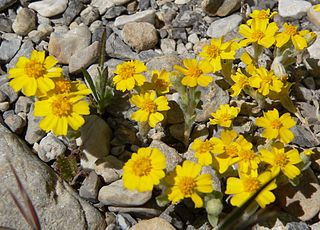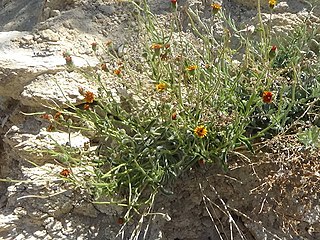
Eriophyllum lanatum, with the common names common woolly sunflower and Oregon sunshine, is a common, widespread, North American plant in the family Asteraceae.

Eriophyllum, commonly known as the woolly sunflower, is a North American genus of plants in the family Asteraceae. The genus is native to western North America, with a concentration of narrow endemics in California.

Eriophyllum lanosum, the white woolly daisy or white easterbonnets, is a spring wildflower in the family Asteraceae. It grows in the eastern Mojave Desert and the Sonoran Desert in the southwestern United States and northwestern Mexico.

Eriophyllum wallacei is a North American flowering plant in the family Asteraceae known by the common names woolly daisy and woolly easterbonnets. It grows in the southwestern United States and northwestern Mexico.

Erigeron eatonii is a North American species of flowering plants in the family Asteraceae known by the common name Eaton's fleabane.

Eriophyllum confertiflorum, commonly called golden yarrow or yellow yarrow, is a North American species of plant in the family Asteraceae, native to California and Baja California. It has wooly leaves when young, and yellow flower heads. "Eriophyllum" means "wooly leaved."
Eriophyllum multicaule is a North American flowering plant in the family Asteraceae, known by the common name manystem woolly sunflower. It is native to California and Arizona in the southwestern United States.

Eriophyllum staechadifolium is a flowering plant in the family Asteraceae which is known by the common name seaside woolly sunflower. It is native to the coastline of Oregon and California including the Channel Islands. This is a plant of the beaches, dunes, and coastal scrub.
Hulsea californica is a rare species of flowering plant in the family Asteraceae known by the common names San Diego alpinegold and San Diego sunflower. It is endemic to southern California, where it grows only in the Peninsular Ranges.

Hulsea vestita is a species of flowering plant in the family Asteraceae known by the common name pumice alpinegold.

Baileya pleniradiata is a North American species of flowering plant in the daisy family, known by the common name woolly desert marigold. It is native to desert regions of the southwestern United States and northern Mexico, where it grows in sandy habitats. It has been found in the States of Chihuahua, Sonora, Baja California, Arizona, Utah, and Nevada.

Eriophyllum mohavense, also known as the Mojave woolly sunflower or the Barstow woolly sunflower, is a rare species of small annual flowering plant in the family Asteraceae, found only (endemic) in the Mojave Desert of California.

Encelia actoni, also known by the common names Acton brittlebush and Acton encelia, is a species of flowering plant in the family Asteraceae.

Enceliopsis nudicaulis is a North American species of flowering plants in the family Asteraceae known by the common name nakedstem sunray, or naked-stemmed daisy.
Eriophyllum congdonii, known by the common name Congdon's woolly sunflower, is a rare California species of flowering plant in the family Asteraceae.
Eriophyllum jepsonii is a rare North American species of flowering plant in the family Asteraceae known by the common name Jepson's woolly sunflower. It is endemic to California, where it has been found in the Central Coast Ranges and adjacent hills from Contra Costa County to Ventura County.

Constancea is a monotypic genus of flowering plants in the family Asteraceae containing the single species Constancea nevinii, which is known by the common name Nevin's woolly sunflower. It is endemic to three of the Channel Islands of California, where it grows in coastal scrub habitat. This is a small shrub or subshrub generally growing up to one or 1.5 meters tall, and taller when an erect form, with a branching, woolly stem. The whitish, woolly oval leaves may be up to 20 centimeters long and are divided into many narrow lobes with edges curled under. The inflorescence is a cluster of 10 to 50 or more small flower heads, each on a short peduncle. The flower head has a center of hairy, glandular, star-shaped yellow disc florets and a fringe of four to nine yellow ray florets, each about 2 millimeters long. The fruit is an achene a few millimeters long with a small pappus at the tip.
Eriophyllum nubigenum, the Yosemite woolly sunflower, is an uncommon flowering plant in the family Asteraceae. It is endemic to California, where it is known only from the Sierra Nevada in and around Yosemite National Park.

Eriophyllum pringlei is a North American species of flowering plant in the family Asteraceae known by the common name Pringle's woolly sunflower. It is native to the southwestern United States and northern Mexico, where it grows in several types of desert, canyon, and hillside habitat, such as chaparral and sagebrush.

Bahiopsis reticulata is a species of flowering plant in the family Asteraceae known by the common names netvein goldeneye and Death Valley goldeneye. It is native to the Mojave Desert of California and Nevada, where it grows in several types of dry desert habitat. Many of the populations are inside Death Valley National Park.














